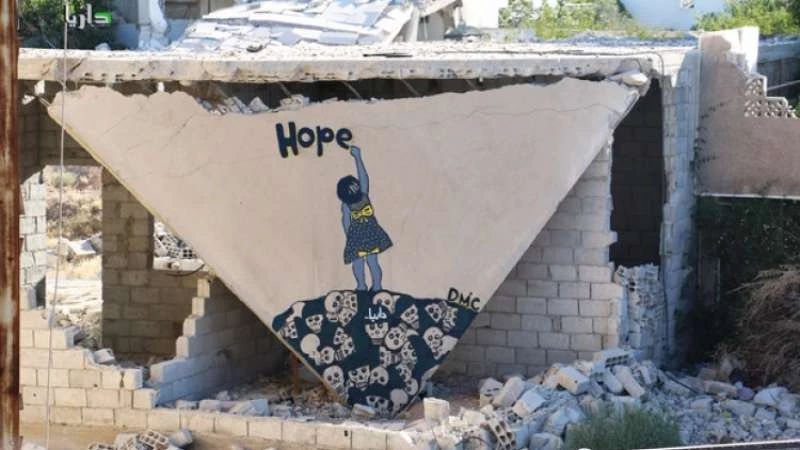Working always under cover of night to avoid detection by the regime snipers who surrounded the city, the slight young man who Barrett Limoges of Middle East Eye (MEE) recently referred to as “Syria’s Banksy” created street art murals that never failed to delight those who knew full well the risks that he took in painting them.
Over the past three years, the anonymous 22 year-old who goes by the name of Shami created 32 murals in a cityscape that had been laid waste by the relentless bombing of the Assad regime and its allies.
As Limoges said in his MEE article published on August 31, they would “crop up randomly, like wildflowers, adorning the ruins of what once were homes, schools and hospitals.”
As one of 1000 opposition fighters who were finally forced to leave the city last week, Shami’s future is as uncertain as the fate of the murals he left behind in the abandoned city which is now under the control of the Assad regime.
It is hard to imagine how desperate the situation had become for the Darayya fighters and residents who had so courageously stood up to Assad and managed to maintain a remarkable four year resistance that Shami’s artwork had helped to inspire.
Keeping his true identity hidden in order to protect family and friends living in regime controlled areas, Shami had taken to signing his murals with the collective signature “Darayya” which symbolized the unity he felt with all who had struggled together to survive in the embattled city.
“I was initially doing this work in secret,” he explained to Limoges. “But people loved it when the work started appearing around town. They really encouraged me and began giving me suggestions on where and what to paint. One man asked if I could draw something on the wall of his destroyed house, but a few days later a barrel bomb fell and crushed the remainder of it.”
Shami had left his Damascus home in January of 2013 to join the Free Syrian Army (FSA) after realizing that protests alone would not be enough to take down Assad whose response to calls for reform was to send snipers to kill unarmed civilians.
He was still in high school when the revolution began, and from the beginning had participated in peaceful protests along with the rest of his large family of political activists.
The defiance of Darayya’s activists had made the Damascus suburb a target of regime shelling early on, so after making the decision to join the opposition fighters Shami headed towards the battle sounds he had been hearing rolling across the hills for months.
More of an artist than a soldier, Shami’s backpack held a change of clothes, a book of Arabic poetry, the Quran, a copy of Victor Hugo’s revolutionary epic Les Miserables, and true to his artistic nature, a sketchbook and some pencils.
Even though he had no formal training as an artist, Shami had already been using his innate skills to support the democratic goals of the revolution with simple illustrations and graffiti.
“When I arrived, the fighters initially laughed at my sketchbook and asked me, ‘What are you planning to do with that?’” Shami told Limoges. “At the time, I just thought it would keep me sane.”
Six months after joining the opposition fighters, Shami began quietly sketching on the walls in the areas he patrolled.
His anonymous works of art soon captured the imagination of the locals, who were inspired by the defiant spirit they portrayed and provided them with a much needed distraction from the difficulties of life under siege.
Contrary to the popularly held belief that Syrians were incapable of governing themselves without the regime, Darayya and other areas of the country under opposition control has set up Local Coordinating Councils to insure that the needs of the residents would be met.
It didn’t take long for the Darayya LCC to realize that Shami’s murals were a valuable asset for keeping the spirits of local residents up and so they encouraged him to do more.
One of the council members, Majd el-Maaddamani, took a particular interest in Shami’s work and began snapping photos and posting them on the council’s Facebook page.
Shami’s murals covered a wide range of political topics and often embodied the dark humor that Syrians have developed over the years as one of the mechanisms they use for coping with unbearable circumstances.
Strategically angled so as to be seen from both “above and below”, the messages conveyed by Shami’s work were directed at the people of Darayya as well as the world beyond the city’s walls.
No doubt the current occupiers of the city will not share our fondness for Shami’s murals, but for three years they stood as evidence of Darayya’s resistance while at the same time serving as a collective cry for help to the whole world from all of Syria’s besieged citizens.
To the world’s utmost shame, all of the cries coming from within Syria have fallen on deaf ears.



التعليقات (0)